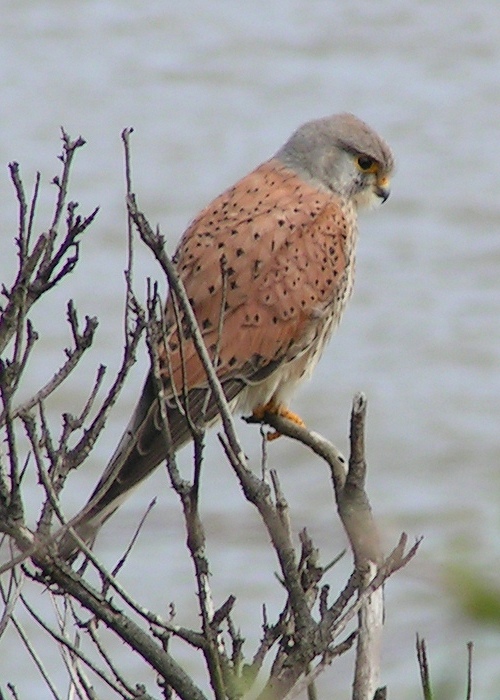|
| Query: bird | Result: 2206th of 32675 | |
Common Kestrel (Falco tinnunculus) - Wiki
| Subject: | Common Kestrel (Falco tinnunculus) - Wiki
| |

| Resolution: 500x700
File Size: 149501 Bytes
Upload Date: 2007:01:08 16:58:15
|
Common Kestrel
From Wikipedia, the free encyclopedia
[Photo] Common Kestrel male. Photo by sannse, May 2004, England. http://en.wikipedia.org/wiki/User:Sannse
The Common Kestrel (Falco tinnunculus) is a bird of prey belonging to the falcon family Falconidae. This species is widespread in Europe, Asia and Africa. The Kestrel is relatively small compared to other predatory birds, but larger than most songbirds. Kestrels have long wings as well as a distinctive long tail. The kestrel's plumage is brown or grey with black spots, and the male has a blue-gray head and tail.
Kestrels measure 34-38 cm from head to tail, with a wingspan of 70-80 cm. The average adult male weighs about 155 g, and the female weighs about 190 g.
Kestrels are diurnal and prefer an "open country" habitat found in fields, heaths, and marshland. When hunting, the Kestrel hovers, almost stationary, about 10-20 m above the ground searching for prey. Once prey is sighted, the Kestrel makes a short, steep dive toward the target. They are often found hunting along the sides of roads and motorways. It has recently been shown that the Kestrel is sensitive to ultraviolet reflectance and hovering helps them pick out the urine trails of rodents which reflect ultraviolet light.
Kestrels prey upon small mammals, including voles, as well as small birds, large insects, earthworms and frogs. A kestrel is capable of spotting prey at amazing distances. It can see and catch a beetle 50 m from its perch. Kestrels need to eat 4-8 voles a day, depending on the time of the year and the amount of hovering they do. They have a habit of catching several voles in succession and cacheing some for later.
Kestrels nest on buildings or reuse the old nests of corvids.
Around 1600, before the F-word was considered too taboo, the Kestrel was briefly referred to as the "windfucker", no doubt due to its habit of occasionally pumping its tail down when hovering into the wind. This term soon fell into disrepute, and was replaced by "windhover", the term also used much later by the poet Gerard Manley Hopkins in his famous poem The Windhover: To Christ our Lord.
There are several other falcons named as kestrels; these include the American Kestrel (Falco sparverius) and the Lesser Kestrel (Falco naumannii).
http://en.wikipedia.org/wiki/Common_Kestrel
| The text in this page is based on the copyrighted Wikipedia article shown in above URL. It is used under the GNU Free Documentation License. You may redistribute it, verbatim or modified, providing that you comply with the terms of the GFDL. |
^o^
Animal Pictures Archive for smart phones
^o^
|
|
|